The Best Ways to Enjoy a Durham Bulls Baseball Game
Take us out to a Bulls game. Take us out for some fun. Buy us a t-shirt and Cracker Jacks. We'll have a great time, and yes,... Read More
Got a couple of hours? How about an afternoon? There's much to discover in and around downtown Durham.
Posted By Ashley Strahm
Downtown Durham, North Carolina’s first commercial district on the National Register of Historic Places, is a compact, vibrant, relatively well-preserved area where buildings date from the first four decades of the twentieth century, when the city boomed. The buildings’ original facades recall the time when Durham became the bustling and ambitious city of today, and a walk through the district reveals a place that honors its history while hosting a renowned food and drink scene and plenty of unique things to do and see.
Downtown Durham is chock full of historic sites and repurposed treasures. With our walking tour, you won't miss a detail.
Before you get started, we've got some tips and tricks to make the most of your trip.
Pick up maps and guides from friendly Durham experts!
Looking for brochures to help you as you navigate Durham? There are a multitude of stops to make that may not have been included here. Pick up a map and guide in the bin outside of the Discover Durham Visitor Info Center or stop in for expert advice Tues-Sat, 10 a.m.-5 p.m.
Where to Park Downtown
Street parking and public garages are fairly easy to find downtown, depending on the time of day, but every city's parking rules have their own nuances. You can find more details on where to park downtown on our parking page.
Make sure to wear something comfortable; this destination was made for walking.
Wear some comfortable shoes and dress according to the season. You can check out our weather guide to make sure you dress comfortably without sacrificing those style points.
We created this guide to show that there's a ton to experience within just a few walkable blocks downtown. Full of history, every building in the Bull City has a story to tell. Get your bearings around downtown by learning the significance of its landmarks. Think of this as a sort of "choose-your-own-adventure" that you can start and end at any district you'd like, and we've also included a few bonus detours. Want to take the tour without staring at your phone? Stop into the Visitor Info Center for a paper version, or print your own.
Before you arrive, get acquainted by using the map below! Each location on the tour is represented by a purple star.
The bulk of this self-guided walking tour will go through the City Center and ATC districts. But, keep your eyes peeled because we've marked out a few extensions to the tour for those interested in exploring other districts. Carve out at least 60 minutes for your tour, but you can make a whole day out of it if you want.
212 W. Main St.
Start out at the Trust Building, which is now home to The Visitor Info Center. When the building was constructed in 1905, it was the tallest in North Carolina and featured Durham’s first elevator. Grab any guides that pique your interest and walk around the corner to 21c Museum Hotel.
111 Corcoran St.
Built in 1935, this 17-story skyscraper was designed by Shreve, Lamb & Harmon, the same NYC architecture firm responsible for designing the Empire State Building. Now, it is home to a boutique museum and hotel featuring a free 24/7 art museum open to the public.
201 Corcoran St.
Continuing on down the street, you'll arrive at CCB Plaza. Named for the former Central Carolina Bank (now Truist), the plaza’s focus is a life-sized, one-ton bronze bull named Major that was designed by artists at Liberty Arts in 2007 and named after George "Major" Watts Hill.
If you're feeling peckish, you can duck into Cheeni or Pour Taproom. Those with a sweet tooth can grab an ice-cream cone at The Parlour to accompany them for the next stop at the tour.
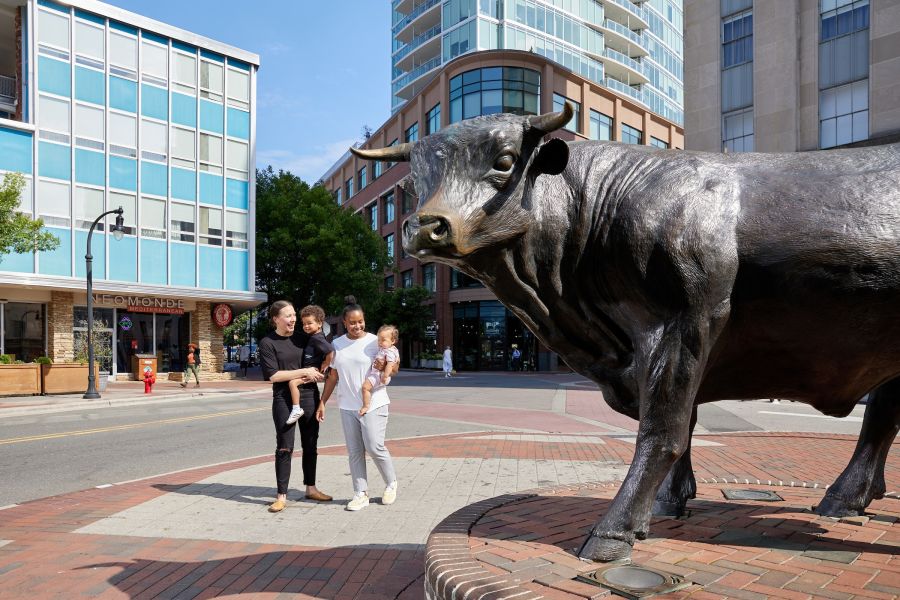
Take a selfie with Major the Bull. Photo: Samantha Everett
202 Corcoran St.
Continuing on the theme of historic buildings turned hotel, you'll be able to see Unscripted Durham from CCB Plaza before taking a right on East Chapel Hill Street toward The Durham Hotel.
315 E. Chapel Hill St.
This boutique hotel, formerly Home Savings Bank, is known for its midcentury modern design, downstairs coffee bar and restaurant and a rooftop bar which boasts one of the best views for sunsets in the city. A few other noteworthy food and beverage spots right by The Durham include Queeny's, Kingfisher, Alley Twenty Six, M Sushi and M Kokko.
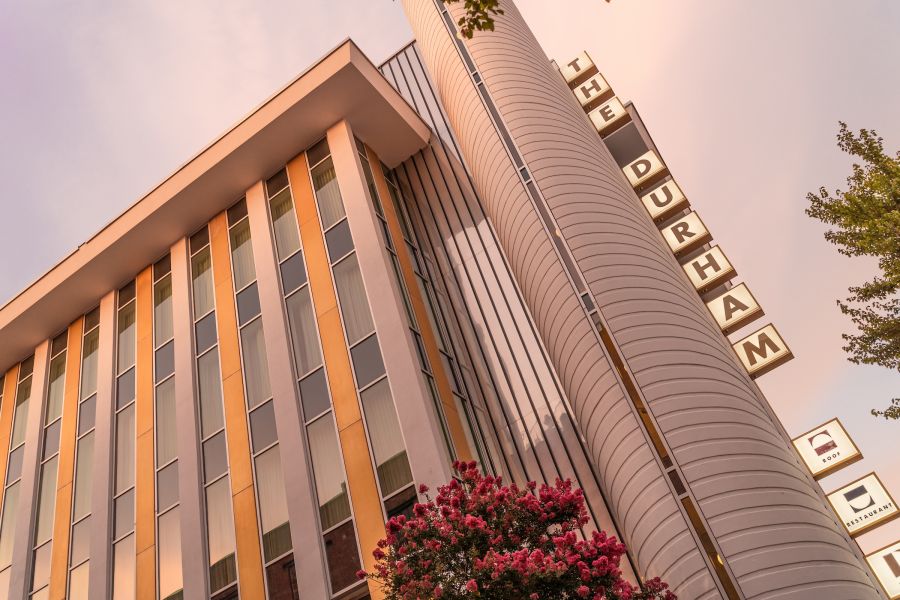
The Durham Hotel is a great spot to book a room or grab a drink. Photo: Discover Durham
Parrish St.
Taking a right on Orange Street will take you to the corner of Parrish and Mangum, where you'll find Black Wall Street. Parrish Street is known for its role as a hub for Black-owned businesses in the late 1800s and early 1900s. The street regained attention in the 1960s when civil rights pioneers staged sit-ins and received a visit from Dr.Martin Luther King Jr. Here, you can explore the Historic Parrish Street Forum and Rogers Alley.
108 W. Parrish St.
Located in the original 1908 headquarters of Durham-founded Mechanic and Farmers Bank, the Historic Parrish Street Forum was developed as a commemorative exhibit that honors the legacy of African American entrepreneurs and businesses. The building now also serves as an event space.
107 E. Parrish St.
Rogers Alley is composed of three buildings converted into a mixed-use complex including the 1904 fire station that is now a pizza restaurant and the Wright Building, known formerly as Roger’s Pharmacy.
If you skipped The Parlour earlier in the tour, you can still grab a scoop here at Simons Says Dip This. Those with an eye for second-hand treasures should make a stop at Durham Vintage Collective, and the Black-owned Ella West Gallery across the street pays homage to the history of Black Wall Street by centering underrepresented local and national artists.
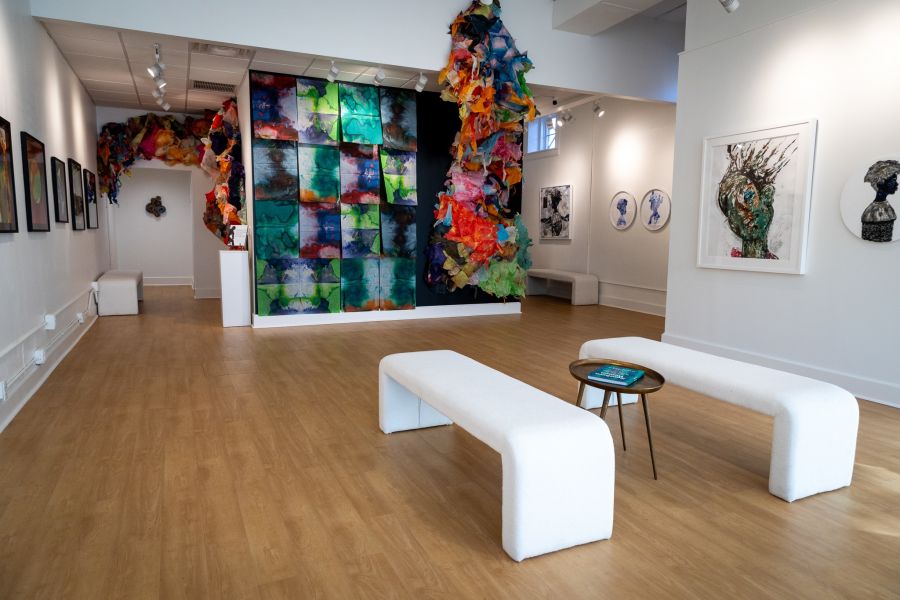
Stop inside Ella West Gallery to get a glimpse of Durham's talented artists. Photo: McKenzie Shelton, Embody Media & Design / Ella West Gallery
215 N. Church St.
From here, you can take a left on Church Street to check out Trinity United Methodist Church, a 1924 Gothic revival church, or continue straight across North Roxboro Street to visit First Presbyterian Church, built in 1916.
305 E. Main St.
This 1916 building stands on the site of two previous churches. Its sanctuary features German stained-glass windows.
200 E. Main St.
Continuing down North Roxboro Street and taking a right on East Main Street will take you to the Historic Durham County Courthouse, a renovated 1916 neoclassical revival that replaced the 1887 courthouse. Continue back up East Main Street to pass a few downtown staples like Bull City Records, 106 Main and Bar Virgile.
101-103 W. Main St.
Further down Main Street, you'll come across the Kress Building. Built in 1932, this structure is one of the largest and most detailed art deco buildings in the state.
111 E. Main St.
Also on East Main Street, you can see the oldest building remaining in the Downtown loop, the 1893 Queen Anne Style Building. Nearby, find the City View First National Bank Building.
123 W. Main St.
Homesite of Durham namesake Dr. Bartlett Durham in the 1840s, this building is now a credit union with a notable flower-swagged canopy.
201 W. Pettigrew St.
Turning left on Corcoran Street will take you to The Old Bull Building, an 1874 Italianate-style brick tobacco warehouse. The bull comes from William T. Blackwell’s brand of Genuine Bull Durham Smoking Tobacco. Declared a National Historic Landmark in 1977, this building is the oldest original building still standing in downtown and marks the northern edge of the American Tobacco Campus.
324 Blackwell St.
Birthed from the American Tobacco Company, one of the first companies included in the Dow International Average in 1896. It was formed as a merger of tobacco companies, including Lucky Strike and Pall Mall. This 1-million-square-foot campus has been revitalized to include a courtyard, a man-made waterway, the iconic Lucky Strike smokestack.
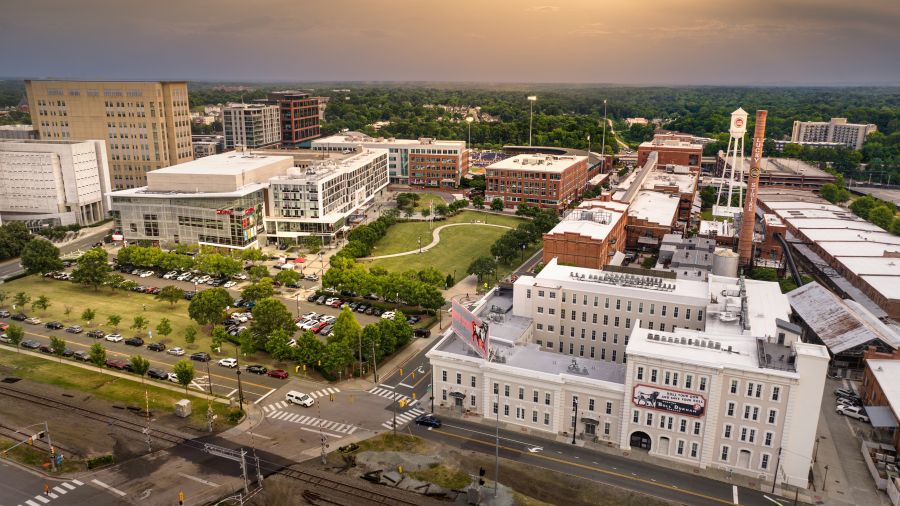
Explore Durham's historic American Tobacco Campus. Photo: HuthPhoto
Within the American Tobacco Campus, you can find plenty of good eats and interesting stores. If you're looking for a coffee or a fun gift for a loved one, check out Parker and Otis. For lunch, try Queenburger or Boricua Soul and for dinner, you can dine at Seraphine, Ekhaya or NanaSteak.
302 W. Main St.
Popping back up onto West Main Street, stroll on over to the Temple Building. This 1909 Spanish colonial-style was built with leftover materials from Watts Hospital, which closed in 1976.
307 W. Main St.
Continuing on your way, this 1925 Georgian revival was commissioned by John Sprunt Hill. Originally the Armory, it is one of the earliest built masonry structures in what is now downtown’s core.
Further up West Main Street, you will find Five Points, which is full of great spots to eat and drink. If you happen to be around in the morning, Ninth Street Bakery is a great option for a coffee and a treat. If you need a bit more to fill the tank, Bull McCabes has a great menu of classic bar fare. For dinner, try tapas at Mateo or wood-fired pizza from Pizzeria Toro.
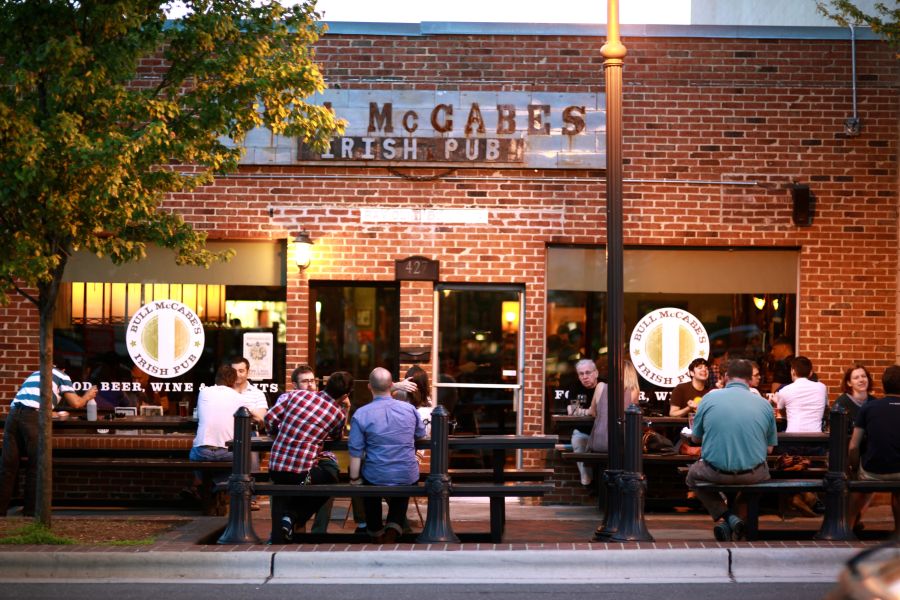
Stop for refreshments at Bull McCabes. Photo: Discover Durham
From here, turn left on West Chapel Hill Street to explore the first detour, Brightleaf Square and the Warehouse District, or you can continue on West Main to visit the Museum of Durham History.
500 W. Main St.
Opened in 2013, this 21st-century museum is dedicated to preserving and promoting local history. Located in a former downtown bus station, this free attraction features rotating exhibits.
120 Morris St.
Head down West Morgan Street, back toward City Center, to see the Durham Arts Council. Formerly 1906 Central High School and later City Hall, this 52,000-square-foot arts center has a performance space, galleries and meeting rooms. Next to the Arts Council, you will find one of Durham's many murals.
110 Morris St.
The Civil Rights mural was researched and designed by thirty diverse community members under the direction of artist Brenda Miller Holmes and educator Dr. Benjamin Speller of North Carolina Central University.
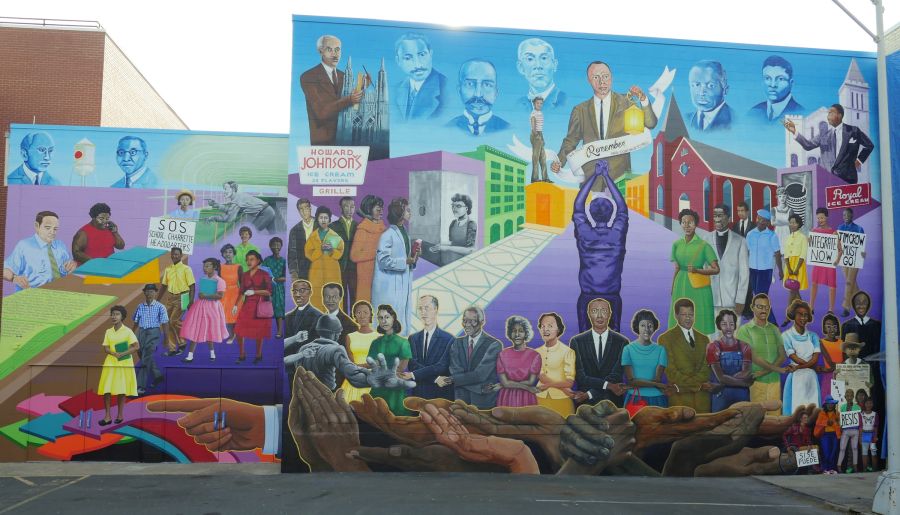
Durham has many amazing murals, like the Civil Rights Mural. Photo: Discover Durham
If you're not quite ready for your tour to end, take a left on Morris Street for a second detour – the Central Park District.
If you're ready to finish your tour of Durham's historic sites, continue onto Morgan Street, where you'll find the Carolina Theatre.
309 W. Morgan St.
This renovated 1926 Beaux-Arts style theatre houses touring acts, live performances and cinemas for arts, films and festivals. It was also the site of civil rights protests in the early 1960s, now documented inside the theatre's “Confronting Change” exhibit. Continue on Morgan Street till Foster Street to see the Durham Armory.
212 Foster St.
Originally built as Durham’s National Guard unit headquarters, this building also served as the original Civic Center from the late 1950s to 1989.
Fun fact about The Armory – it's the site of a gathering that the artist Ernie Barnes, who grew up in Durham, secretly spied on before he was of age to attend. This scene inspired the famous "The Sugar Shack" painting from 1976. Taking a right on East Chapel Hill Street will bring you to the last stop of the tour.
115 Market St.
Formerly the home of the Herald-Sun newspaper, this structure was built in 1920s with Italian Renaissance styling.
From the Visitor Info Center, down West Main Street before Duke’s East Campus, you’ll pass through the Warehouse and Brightleaf Districts. Brightleaf Square is made up of two turn-of-the-century tobacco warehouses adapted into retail, dining and office spaces. You can tour this area on its own, or include it as a leg of your downtown tour.
411 W. Chapel Hill St.
Start off at the North Carolina Mutual Life Insurance Company building on West Chapel Hill Street. Founded in 1898, this is one of the largest and oldest Black-owned corporations in the country. It is now home to Provident 1898, an inclusive co-working space and nod to the building's origins. Next, Take a right on South Duke Street to visit the Duke Memorial United Methodist Church.
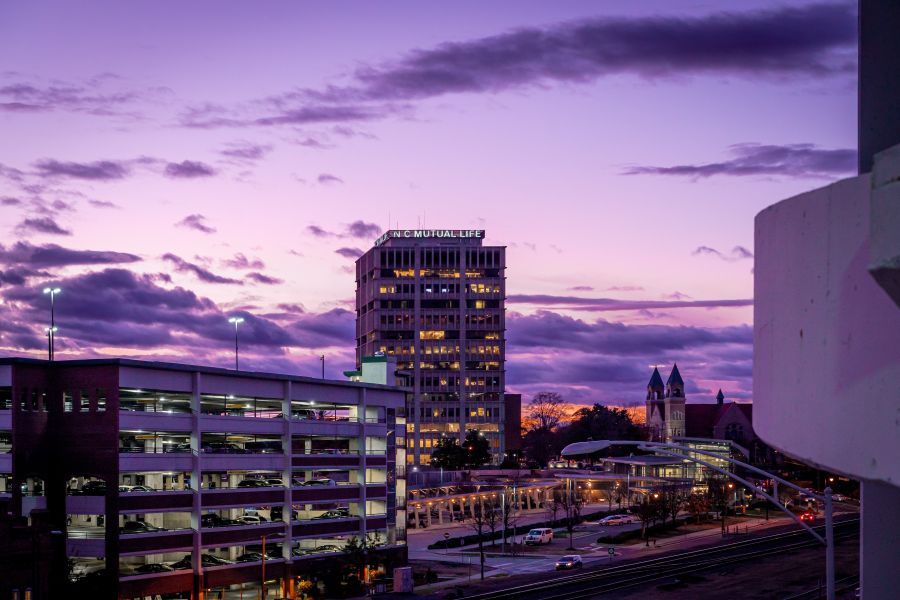
The NC Mutual Building is a Durham skyline icon. Photo: Discover Durham
504 W. Chapel Hill St.
Beginning as Main Street Methodist, this twin-towered, brick Romanesque and Gothic revival style church was built in 1907. Named for its benefactor, Washington Duke, it features a 10-bell chime. Keep on walking till you take a left on West Main Street and enter Brightleaf Square.
905 W. Main St.
Brightleaf Square is a collection of Neo-Romanesque brick tobacco warehouses redeveloped in 1981. It is now a popular gathering spot with a central courtyard, shopping and dining. Brightleaf Square holds a number of Durham's most treasured dining options. Grab a coffee at Gojo by Goorsha. Savor a bowl of tonkotsu ramen or a katsu sando at Rose's Noodles, Dumplings & Sweets. Enjoy a night of fun and drinks at Clouds Brewcade + Kitchen.
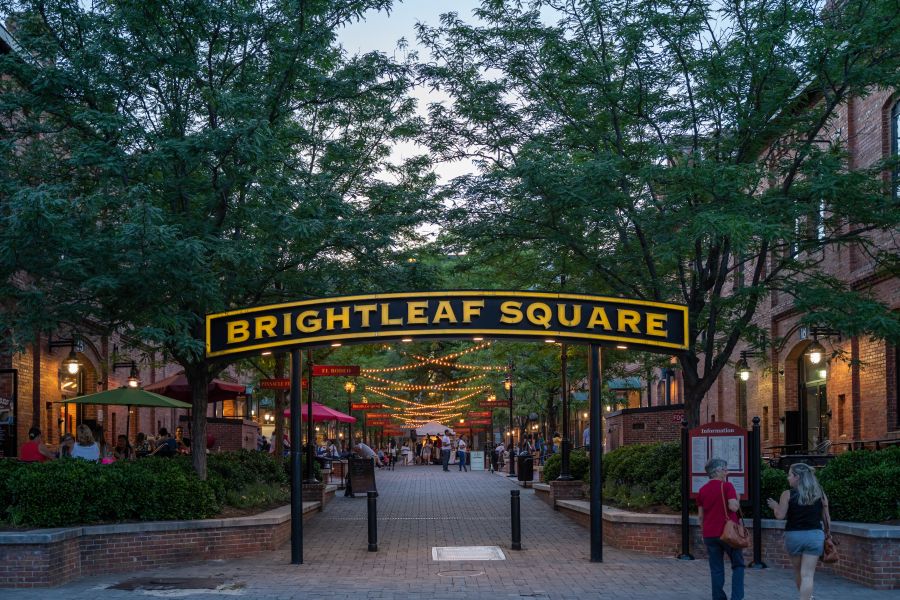
Enjoy shopping, drinking and eating at Brightleaf Square. Photo: Discover Durham
604 Morgan St.
Heading back down W. Main Street, you will come across West Village, a several-block project that converted former Liggett & Myers tobacco buildings into loft-style apartments, retail, offices and Durham’s train station. At the time, this was one of the largest adaptive reuse projects in North Carolina history.
From here, you can pick back up on the main tour route at the intersection of Morgan Street and Morris Street.
The Central Park District is, naturally, home to Durham Central Park, a five-acre public space with a playground, skate park, covered pavilion, art studios, public art and a spacious grassy lawn where thousands of people shop weekly at the Durham Farmers’ Market. The Central Park District is the second detour of the main tour, but you can take part in this tour on its own as well.
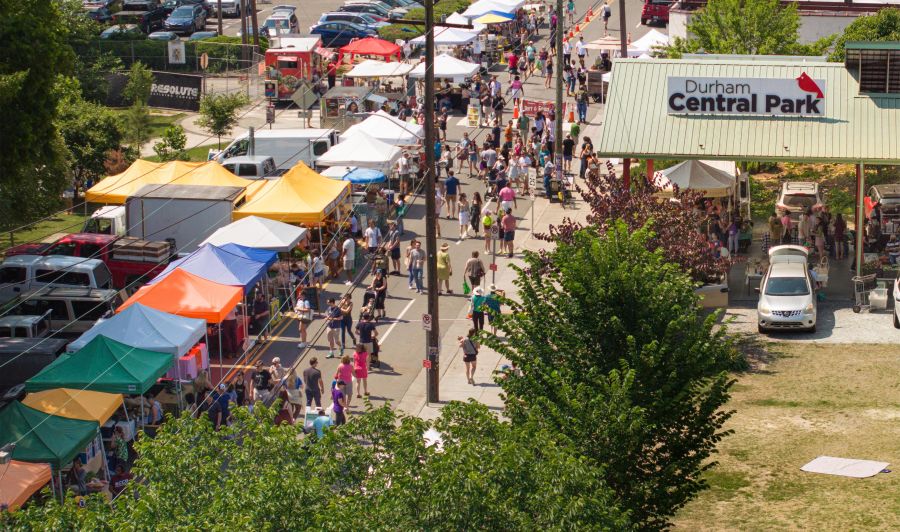
Take your tour on a Saturday morning for a chance to visit the Durham Farmers' Market. Photo: HuthPhoto
215 Morris St.
Begin your tour of the district by heading to the Former Imperial Tobacco Warehouse. Tobacco was re-dried in this 1916 warehouse before being shipped to Great Britain. For any film buffs out there, the locker room scenes from “Bull Durham” were also filmed here.
Continuing further up Morris Street will take you to the Historic BC Headache Powder Factory.
423 Morris St.
From 1928-1972, the headache remedy was manufactured here, but the building is now home of Measurement Inc. and part of the Innovation District, an ever-evolving redevelopment combining historic buildings with new lab, office, residential and retail space.
Keep walking until you see the Historic Durham Athletic Park on your right.
500 W. Corporation St.
Originally named El Toro Park when it was built in 1926, this spot served as the home of the Durham Bulls for almost 70 years. The park was a film location for the movie “Bull Durham,” filmed here in 1987. In 1995, the team moved to the Durham Bulls Athletic Park located a mile south.
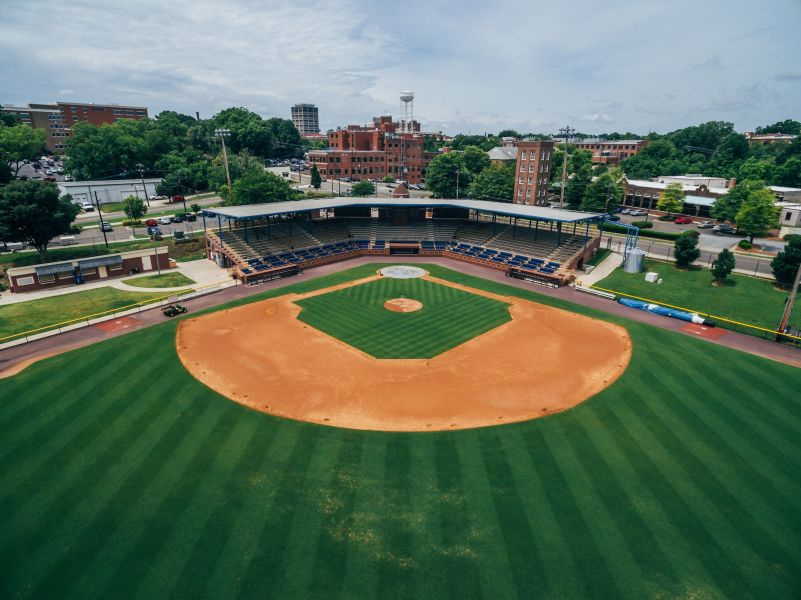
Baseball fans won't want to miss the Historic Durham Athletic Park. Photo: Estlin Haiss
For a few of Downtown Durham's larger attractions, you may want to set aside a whole afternoon. These locations present city visitors with an opportunity to understand Durham's past and present in a unique way. Read on to the articles below to find out more.
The Best Ways to Enjoy a Durham Bulls Baseball Game
Take us out to a Bulls game. Take us out for some fun. Buy us a t-shirt and Cracker Jacks. We'll have a great time, and yes,... Read More
A Guide to Durham Performing Arts Center, DPAC
Explore your guide to Durham Performing Arts Center, complete with venue details, recommendations and FAQs. Read More
20 Facts About American Tobacco Campus
From Broadway to baseball and outdoor concerts to fine dining, American Tobacco Campus is a hotspot for locals and visitors alike. Read More